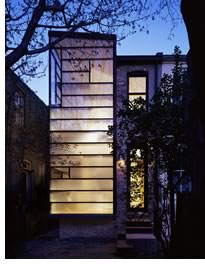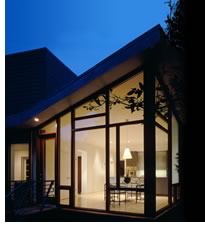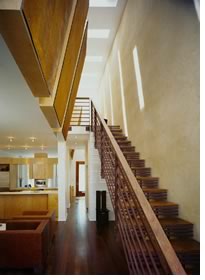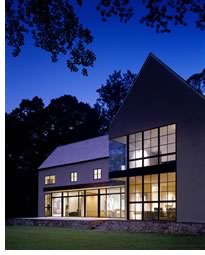

08/2005
 David Jameson, AIA,
one of five recipients of the Young Architects Award in 2004, makes design
the cornerstone of his Alexandria, Va., practice. His clean, crisp lines
and compositions that foil texture, materials, and shape are the hallmarks
of his studio. With about 80 percent of his practice devoted to residential
architecture, Jameson’s work includes a range of large- and small-scale
projects. A graduate of Virginia Tech in 1990, he worked for the prestigious
firms of Hugh Newell Jacobsen and Cooper Lecky Architects before hanging
out his shingle in 1997.
David Jameson, AIA,
one of five recipients of the Young Architects Award in 2004, makes design
the cornerstone of his Alexandria, Va., practice. His clean, crisp lines
and compositions that foil texture, materials, and shape are the hallmarks
of his studio. With about 80 percent of his practice devoted to residential
architecture, Jameson’s work includes a range of large- and small-scale
projects. A graduate of Virginia Tech in 1990, he worked for the prestigious
firms of Hugh Newell Jacobsen and Cooper Lecky Architects before hanging
out his shingle in 1997.
 “I always had an interest in the making of things,” says
Jameson. “When I was a kid growing up on the Eastern Shore of Maryland,
the local paper featured a “Home of the Week” in the Sunday
edition. I loved looking at those and reconfiguring the layout of the
homes. And when I got to 7th grade, I spent a lot of time in shop class—especially
metal shop. I enjoyed using the saws and other tools and liked watching
things take shape.”
“I always had an interest in the making of things,” says
Jameson. “When I was a kid growing up on the Eastern Shore of Maryland,
the local paper featured a “Home of the Week” in the Sunday
edition. I loved looking at those and reconfiguring the layout of the
homes. And when I got to 7th grade, I spent a lot of time in shop class—especially
metal shop. I enjoyed using the saws and other tools and liked watching
things take shape.”
Architect or baseball player?
Jameson also credits spending his childhood vacations traveling to his
father’s annual CPA conventions across the country for instilling
in him a love of architecture. “We would pack up the camper and
drive to a different town every summer,” he says. “If you’re
a tourist, what do you do when you’re in a new town? You look
at the buildings. We looked at the architecture in San Francisco, Boston,
New York City. And all the time, I just thought about how amazing it
would be to have a career designing the built environment. Well, it
was either that or be a Major League Baseball player.”
 During Jameson’s eight years since opening up shop, he has received
more than 40 design awards from local, state, and national AIA components
and has been featured in numerous design magazines and on HGTV. Fairfax
County, Va., also recognized Jameson with its Exceptional Design Award,
and the International Masonry Institute has twice recognized his work. “Every
project starts with design, whether it’s $10,000, $100,000, or
a million dollars,” he says. “This practice is unique because
we’re interested in working with people who are interested in design.” At
the moment, Jameson is working on a Japanese tea house in the backyard
of a private residence. “It’s going to be traditional in
that it’s a real, functioning tea house, but Modernist because
it’s unique and responds to the site. It’s a little bit like
buying a sculpture for your backyard, except that you can actually sit
in it and enjoy it.”
During Jameson’s eight years since opening up shop, he has received
more than 40 design awards from local, state, and national AIA components
and has been featured in numerous design magazines and on HGTV. Fairfax
County, Va., also recognized Jameson with its Exceptional Design Award,
and the International Masonry Institute has twice recognized his work. “Every
project starts with design, whether it’s $10,000, $100,000, or
a million dollars,” he says. “This practice is unique because
we’re interested in working with people who are interested in design.” At
the moment, Jameson is working on a Japanese tea house in the backyard
of a private residence. “It’s going to be traditional in
that it’s a real, functioning tea house, but Modernist because
it’s unique and responds to the site. It’s a little bit like
buying a sculpture for your backyard, except that you can actually sit
in it and enjoy it.”
 Striving for balance
Striving for balance
A progressive office environment also defines Jameson’s practice.
A member of AIA Northern Virginia’s board of directors, Jameson
makes a habit of volunteering in his professional community. He has served
on the Virginia Society of the AIA Design Committee, as a visiting critic
to the Virginia Tech Washington-Alexandria Center for Architecture and
Urban Studies, and as a volunteer in local elementary schools for the “Architecture
in Our Schools” program. Jameson strongly believes in the importance
of carving out time for volunteer work and family life. As a result,
his firm doesn’t meet with clients after hours or on weekends and
closes at 12:30 p.m. on Friday afternoons. “Monday through Thursday
we work extremely hard so that on Fridays we can manage other commitments,” he
says. He does note that it can be hard to convince clients to meet with
him during office hours, but he believes that, as a result of their decision
to stick to office hours, the clients “treat the project more seriously,
not as an afterthought.”
Although Jameson’s firm now has a staff of five, has garnered significant acclaim, and developed a strong local following, it wasn’t so easy when he started his practice. He says that although he had apprenticed with Jacobsen and cut his teeth on multi-million dollar projects, the hardest thing was finding people who were willing to trust a “young, punk kid” with their home renovation or expansion project. His first design project on his own was a garage with owners who asked, “Do you have enough experience to do a $25,000 project?”
 “It wasn’t a phenomenal time to start—not like in
the late ’90s,” says Jameson. “At the time, there weren’t
so many available projects that clients were beating down the door, but
the one advantage it did afford was that I was able to spend a lot of
time to do a really nice job on each project—not that we don’t
spend a tremendous amount of time on projects now.”
“It wasn’t a phenomenal time to start—not like in
the late ’90s,” says Jameson. “At the time, there weren’t
so many available projects that clients were beating down the door, but
the one advantage it did afford was that I was able to spend a lot of
time to do a really nice job on each project—not that we don’t
spend a tremendous amount of time on projects now.”
A “paradigm shift”
Jameson believes that this is a great era for the architecture profession,
saying that he can’t recall a time when the American public was
more receptive to design and that he hopes the current interest will
allow architects to reclaim ground as the master builder. “The
practice of architecture has become much more integrated,” states
Jameson. “Architects are now doing more holistic projects and
including previously foregone areas like assisting the owners with
selecting art, furnishings, and landscape design. And then you have
designers like Karim Rashid who are crossing over into graphics. It’s
a real paradigm shift.”
 He also notes that—because design awareness in consumers has become
so elevated—clients are now much savvier. They regularly request
information on sustainability and ask to integrate green features when
they make sense. “We’re doing a lot more geothermal and mechanical-systems
work now. Clients today understand that green design is more expensive
and they want to make the right choice. Our firm looks at sustainability
from a slightly different perspective. We don’t just evaluate how
the products are harvested, but also look at their authenticity in materiality
and life-cycle costs. The way we look at it is, if the clients make the
investment to have the authentic products, they save on maintenance costs.
That means the maintenance man doesn’t drive across town in his
car creating pollution and the materials don’t have to be replaced
as soon and go to a landfill. We look for products that make sense and
help the environment in more ways than how they were harvested.”
He also notes that—because design awareness in consumers has become
so elevated—clients are now much savvier. They regularly request
information on sustainability and ask to integrate green features when
they make sense. “We’re doing a lot more geothermal and mechanical-systems
work now. Clients today understand that green design is more expensive
and they want to make the right choice. Our firm looks at sustainability
from a slightly different perspective. We don’t just evaluate how
the products are harvested, but also look at their authenticity in materiality
and life-cycle costs. The way we look at it is, if the clients make the
investment to have the authentic products, they save on maintenance costs.
That means the maintenance man doesn’t drive across town in his
car creating pollution and the materials don’t have to be replaced
as soon and go to a landfill. We look for products that make sense and
help the environment in more ways than how they were harvested.”
Copyright 2005 The American Institute of Architects.
All rights reserved. Home Page ![]()
![]()
 |
||
|
||